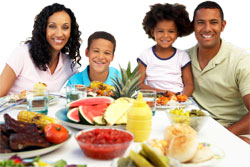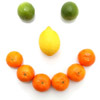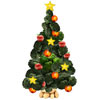- Introduction
- How common are festive season accidents and injuries?
- What dangers can Christmas bring?
Introduction
Christmas is a time for fun and family. However, the traditions of Christmas, from the tree to the turkey, can create dangers which may put a damper on the festive spirit. Each year thousands of individuals sustain injuries in the process of decorating for the festive season and there is also an increased risk of hazards like food poisoning and home fires at this time of year. Yet these injuries and accidents are largely preventable. With proper planning and care, it’s possible for the entire family to celebrate with festive flair while avoiding the dangers that arise more commonly in the festive season.
How common are festive season accidents and injuries?
Accidents and injuries can happen at any time of year; however some accidents are specific to the Christmas season, or more likely to happen at this time of year. For example, house fires started by Christmas trees are unlikely to occur outside of the festive season. In the United States 240 house fires start each year when a Christmas tree catches alight. These fires are the cause of 13 deaths, 27 injuries and $16.7 million worth of property damage each year. Fires which start from a Christmas tree result in death more frequently than fires which start from other sources.
There are also thousands of Christmas-related injuries which occur each year, many as a result of a fall from a ladder, table or other raised surface from which the person was erecting Christmas decorations. In the United States 12,100 falls related to Christmas decorating occurred in the 2010 festive season, an increase from earlier in the decade when 17,465 holiday-decorating related falls occurred in a three year period (2000–2003), or an average of just 5,822 injuries per annum. This equated to 8.1 injuries per 100,000 people.
Of these injuries, 34% were fractures, 46% affected the extremities (arms and legs) and 43% occurred as a result of a fall from a ladder. Amongst those who fell from ladders, almost half were hospitalised as a result of their injuries, compared to 12% hospitalised for all holiday decorating related injuries, and 9% hospitalised for non-holiday decorating injuries. Roofs and furniture were commonly the site of falls. The majority of falls affected individuals aged 20–49 years and men were 40% more likely to injure themselves by falling compared to women.
Accidents which result from carrying luggage are also more prevalent in the festive season and in 2010 some 54,000 individuals in the United States sustained injuries (e.g. to the back, shoulders and neck) as a result of carrying luggage.
What dangers can Christmas bring?

Fire hazards
Christmas trees and the lights and other decorations with which they are adorned are all fire hazards. Fires involving Christmas decorations may occur as a result of electrical faults, because decorations are placed too close to heat sources such as fires, or due to incorrect disposal, for example when a fire started to burn off an old Christmas tree gets out of control. These fires can be prevented with careful planning and simple safety measures, including:
- Select the right Christmas tree and safe decorations:
- Choose an artificial Christmas tree which is labelled “Fire Resistant”;
- Choose the freshest possible pine tree if you opt to use a real tree for decoration. A fresh tree is green, needles are hard to pull from branches and bend easily between the fingers without breaking. The needles should not fall off when the tree is tapped on the ground. The trunk will be sticky with resin;
- Ensure all Christmas tree decorations are non-combustible or flame-resistant. For example, choose tinsel or artificial icicles made from plastic or non-leaded metals;
- Never use lighted candles on a Christmas tree or near other trees. If you choose to use candles at Christmas time (e.g. for Carols by Candlelight), always place them in a non-flammable holder, and position them where they will not be knocked down.
- Position and store the tree safely:
- Ensure the Christmas tree is away from fireplaces, radiators or portable heaters. Place the tree out of the way of traffic and do not block doorways;
- Cut a few inches off the trunk of your tree to expose the fresh wood. This allows for better water absorption and will help to keep your tree from drying out and becoming a fire hazard;
- Be sure to keep the tree watered because with proper watering it is less likely to dry out and become a fire hazard;
- Remove all wrapping papers, bags, paper, ribbons and bows from tree and fireplace areas after gifts are opened. These items can cause a fire if near flame.
- Check electrified Christmas decorations thoroughly before use:
- Never use electric lights on a metallic tree. The metal branches of the tree can conduct electricity from the lights which may result in electrocution if someone touches a branch;
- Before electrifying outdoor lights, check the package label to be sure they have been certified safe for outdoor use. Ensure the lights are held tightly in place, for example by stringing them through hooks or insulated staples. Do not use nails, tacks or other metal fasteners as these conduct electricity. Remove the fasteners before taking down the Christmas lights. Never pull or tug lights to remove them;
- Check all tree lights to ensure every bulb is working and there are no frayed or loose electrical wires or broken connections. This is an important step even if the lights are brand new;
- Plug outdoor electric decorations into circuits with ground fault circuit interrupters. This will help avoid electric shocks;
- Turn off all Christmas lights before bed or leaving the house. The lights could short out and start a fire.
Injury
Injuries such as suffocation, cuts, fractures and burns can damper the festive spirit. These injuries will be less likely if you take some simple precautions:
To avoid injuries when decorating the Christmas tree and house:
- Don’t drink and decorate: Alcohol impairs cognitive and motor skills (your ability to think and coordinate your movements) and increases the risk of falling. Leave your celebratory drinks for after the decorating;
- Select the right ladder for the job:
- When working at low and medium heights, choose step stools or utility ladders. Extension ladders are ideal for use outdoors to reach high places, such as hanging items from the rooftop;
- The weight the ladder is supporting should never exceed its maximum load capacity;
- Do not stand on furniture for indoor decorating. Use a step ladder instead;
- Inspect the ladder before use to ensure there are no loose rungs or screws. Clean the rungs of the ladder before use to prevent slipping;
- Set up the ladder on a firm piece of ground close to your work area. Check for soft or uneven ground before setting up the ladder
- Position the ladder an appropriate distance from the wall. The bottom of the ladder should be 0.3 metres away from the wall for every 1.2 metres that it rises up the wall;
- Move carefully on the ladder to avoid losing your balance;
- Wear proper footwear with good grip when using a ladder;
- Avoid decorations that are sharp or breakable, especially in homes with small children. Take special care to keep trimmings with small removable parts out of the reach of children to avoid them from swallowing or inhaling small pieces. Avoid trimmings that resemble candy or food that may tempt a young child to eat them;
- Wear gloves to avoid eye and skin irritation while decorating with spun glass “angel hair.” Follow container directions carefully to avoid lung irritation while decorating with artificial snow sprays.
To avoid Christmas present related injuries:
Dispose of all wrapping papers, bags, paper, ribbons and bows once the presents are opened. These items can pose suffocation and choking hazards to a small child;
- Select toys to suit the age, abilities, skills and interest level of the intended child. Toys which are too advanced may pose safety hazards for younger children;
- Before buying a toy or allowing your child to play with a toy that they have received as a gift, read the instructions carefully;
- To prevent both burns and electrical shocks, don’t give young children (under age 10) a toy that must be plugged into an electrical outlet. Instead, buy toys that are battery-operated;
- Children less than 3 years can choke on small parts contained in toys or games. Check the children’s toys for small parts before allowing them to play;
- Children under age 8 can choke or suffocate on uninflated or broken balloons and other toys with strings. Remove strings and ribbons from toys before giving them to young children;
- Watch out for pull toys with strings that are more than 30 cm in length. They could be a strangulation hazard for babies.
To avoid lifting injuries:
- Use the proper lifting technique every time you pick up a load. Bend at your knees not at your back. Avoid bending or twisting the spine at any time while you are carrying a load;
- Ask for help when lifting something heavy;
- When doing the Christmas shopping, be careful not to overload. Make several trips to the car to store your purchases and prevent carrying a large load that might cause an injury;
- Pack lightly for festive season holidays;
- Check all heavy luggage; do not try to take it as carry-on luggage;
- Use luggage with wheels to reduce the need for lifting;
- Take care when placing luggage in the overhead compartment of an aeroplane, train or other transport. Ask for help if your luggage is too heavy. If you can lift the item yourself begin by lifting it to the back of the chair first. From here you can position your hands properly and lift to the compartment. Always put the wheel into the compartment first if you are using luggage with wheels.
To avoid sport and recreation injuries:
- Use appropriate safety equipment for the sport or game you’re playing. For example, wear a helmet or padding when playing contact sports, or ensure you have adequate warm clothing if hiking;
- Drink plenty of fluids to avoid dehydration;
- Take time to warm up your muscles before playing sport to reduce the risk of muscle injuries;
- Use sun protection, including a broad spectrum 30+ sunscreen, a hat and protective clothing. The sun is hottest between 10 am and 3pm so sun protection is particularly important at these times;
- Seek medical attention immediately if anyone is injured.
To avoid food preparation injuries:
- Keep hot liquids and foods away from the edges of counters and tables, where they can be easily knocked over by a young child’s exploring hands;
- Use knives which are the correct size for the food you are cutting;
- Use only microwave-safe containers in the microwave.
To avoid road traffic injuries:
- Ensure you are well-rested before undertaking a long trip;
- Take frequent breaks when driving long distances. It is recommended that you spend at least 15 minutes away from the wheel for every 2 hours of driving. Planning rest stops before you set out can help ensure you take frequent breaks;
- Be flexible with your travel plans so that you can stop driving if you get too tired;
- Stick to the speed limit. Driving above the speed limit is a contributing factor in 40% of road traffic accidents;
- Drink alcohol in moderation. The risk of short term injuries such as falls or assault-related injury increases with increasing alcohol intoxication. Moderating alcohol consumption is particularly important for individuals who will be driving. They should ensure they consume no more than one standard drink per hour.
To avoid other injuries:
- Be aware that re-positioning furniture can increase the risk of a fall as people will be unfamiliar with the layout of the room. For example, someone may trip over a piece of furniture which has been moved to a previously open space in the living room;
- Clean up immediately after a holiday party, not the next morning. A toddler could rise early and choke on leftover food or small objects lying on the floor;
- Drink alcohol in moderation. The risk of short term injuries such as falls or assault-related injury increases with increasing alcohol intoxication.
Food poisoning

- Fully cook meats and poultry, to eliminate bacteria which can cause food-borne disease. Ensure you leave sufficient time for cooking the Christmas lunch, bearing in mind that an average size turkey (4.5–6.5kg) needs 40 minutes cooking time per kilogram. Check the meat is thoroughly cooked by cutting the thickest part of the turkey or checking it with a thermometer (the temperature should be ≥70oC);
- Thoroughly wash raw vegetables and fruits. Bacteria which cause food poisoning are often present in raw foods;
- Wash your hands frequently, and make sure your children and others involved in food preparation do the same;
- Never put a spoon used to taste food back into food without washing it;
- Always keep raw foods and cooked foods separate, and use separate utensils when preparing them;
- Always thaw meat in the refrigerator, never on the countertop. Use a sealed container to ensure blood from the meat does not drip onto other food. Ensure you leave sufficient time for meat to fully defrost before cooking. A turkey can take up to 12 hours per kg to defrost in the refrigerator;
- Foods that require refrigeration should never be left at room temperature for more than 2 hours.Ideally cooked foods should be cooled immediately and placed in the refrigerator within 1 hour;
- Always thoroughly reheat leftovers before eating. Only reheat food once.
Visiting
- Clean up immediately after a holiday party, not the next morning. A toddler could rise early and come in contact with alcohol or tobacco left over from the party;
- When visiting friends and family, remember that their homes may not be childproofed. Keep an eye out for danger spots. Be aware that poisoning is more likely to occur in times of disruption, like when visiting another home;
- Travelling, visiting family members, getting presents, shopping, and other festive season activities can all increase your child’s stress levels. Trying to stick to your child’s usual routines, including sleep schedules and timing of naps, can help you and your child enjoy the holidays and reduce stress.
 |
For more information about food safety and tips for keeping your food bacteria-free, see Food Poisoning Prevention and Food Safety. |
 |
For more information about good foods to eat of the festive season and tips for maintaining your diet, see Diet over the Festive Season. |
References
- Stephens JA, Fall-related injury during the holiday season- United States 2000-03. Mortality and Morbidity Weekly Report. 2004; 53(48): 1127-29. [Full Text]
- Healthy Christmas eating [online]. London: Food Standards Agency UK; 2009 [cited 11 December 2009]. Available from: URL link
- Ahrens M, Home Christmas tree and Holiday lights fires. 2011. National Fire Protection Authority. [cited 26 November 2011] Available from: [URL Link]
- American Association of Orthopaedic Surgeons. About Holiday Safety. 2011. [cited 28/11/2011]. Available from: [URL Link]
- American Academy of Paediatrics. Holiday Safety Tips. Holiday Safety Tips. 2005. [cited 28 November 2011]. Available from: [URL Link]
- National Health and Medical Research Centre. Australian guidelines to reduce health risks from drinking [online]. 6 March 2009 [cited 22 August 2009]. Available from: [URL Link]
- Australian Cancer Council. Preventing skin cancer. 2011. [cited 28 November 2011. Available from: [URL Link]
- City of Toronto. Injury Prevention: At home alone. 2011. [cited 28 November 2011]. Available from: [URL Link]
- Driver Reviver. Holiday motoring tips. 2008. [cited 28 November 2011]. Available from: [URL Link]
- NSW Roads and Traffic Authority. NSW Speed Zoning guidelines. 2011. [cited 28 November 2011]. Available from: [URL Link]
- Children’s Hospital Westmead Poison’s Information Centre. Kids and Poisons Fact Sheet. 2010. [cited 28 November 2011]. Available from: [URL Link]
All content and media on the HealthEngine Blog is created and published online for informational purposes only. It is not intended to be a substitute for professional medical advice and should not be relied on as health or personal advice. Always seek the guidance of your doctor or other qualified health professional with any questions you may have regarding your health or a medical condition. Never disregard the advice of a medical professional, or delay in seeking it because of something you have read on this Website. If you think you may have a medical emergency, call your doctor, go to the nearest hospital emergency department, or call the emergency services immediately.

 Dispose of all wrapping papers, bags, paper, ribbons and bows once the presents are opened. These items can pose suffocation and choking hazards to a small child;
Dispose of all wrapping papers, bags, paper, ribbons and bows once the presents are opened. These items can pose suffocation and choking hazards to a small child;





